PREVENTING DISEASE
|
A BRIDGE FOR PEACE
"Today health is seen as a human right and as a foundation of peace among nations."
—Carlyle Guerra de Macedo, Pan American Health Organization, 1986
The successful campaign against smallpox inspired confidence that other diseases could also be eliminated. In 1985, the Pan American Health Organization
(PAHO) launched a campaign to eradicate polio from the Americas. At the time, Central Americans faced major health problems due to ongoing conflict in
Guatemala, El Salvador, and Nicaragua. As well as injuries caused by the violence, the warfare had a devastating impact on living conditions and health services.
PAHO worked with government leaders, combatants, and local organizations to create Health as a Bridge for Peace—a plan to end hostilities and provide medical care.
HEALTH AS A BRIDGE FOR PEACE:
Building peace and improving health
Transcript
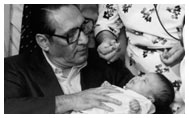 President José Napoleón Duarte holding the first child in the PAHO campaign to be vaccinated against polio, 1985
President José Napoleón Duarte holding the first child in the PAHO campaign to be vaccinated against polio, 1985
Courtesy UNICEF HQ Photography Unit/Dennis Bidd Gray
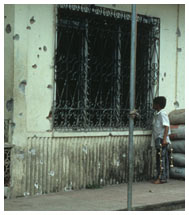 Bullet holes in the walls of La Clinica Fatima Pavon, La Trinidad, Nicaragua, 1987
Bullet holes in the walls of La Clinica Fatima Pavon, La Trinidad, Nicaragua, 1987
Courtesy Walter J. Lear, M.D.
Five years after the Sandinista National Liberation Front overthrew Nicaragua's military dictatorship, a rebel army, the Contras, launched a campaign against them. In an effort to wear down
public support for the Sandinista government, the rebels attacked citizens and targeted facilities crucial to health and welfare. On August 1, 1985 in La Trinidad, Nicaragua, 150 Contra soldiers opened fire on a local clinic.
They burned the clinic's jeep, shot down the door of the pharmacy, stole antibiotics, and destroyed the rest of the drugs.
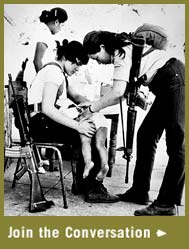 Guerilla soldiers providing vaccinations, El Salvador, 1980s
Guerilla soldiers providing vaccinations, El Salvador, 1980s
Courtesy PAHO Archives
In El Salvador, after more than six months of negotiations, the President and opposition forces agreed to a temporary ceasefire to allow for immunizations. 20,000 people, including health workers, volunteers, and guerrilla forces gave vaccinations to the country's children.
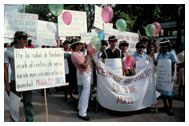 A parade to publicize an immunization campaign, Honduras, 1986
A parade to publicize an immunization campaign, Honduras, 1986
Courtesy PAHO Archives
Education campaigns were launched in countries across Central America to promote "immunization days" and encourage everyone to participate. Health workers organized parades to advertise the event,
as well as posters, concerts, and house-to-house visits.
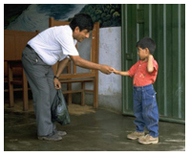 Luis Fermín Tenorio with his doctor, Roger Zapata, M.D., Peru, ca. 1991
Luis Fermín Tenorio with his doctor, Roger Zapata, M.D., Peru, ca. 1991
Courtesy PAHO Archives
The Pan American Health Organization launched a campaign to eradicate polio from the Americas in 1985. On August 23, 1991, in rural Pichinaki, Peru, two-year-old Luis Fermín Tenorio Cortez was
identified as the last known case of polio in the Americas. He had been prevented from completing his polio immunization because the local health center was damaged in conflict.
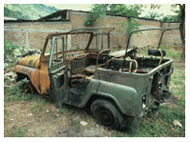 Clinic jeep, used to deliver medicines, after an attack on La Clinica Fatima Pavon, La Trinidad, Nicaragua 1987
Clinic jeep, used to deliver medicines, after an attack on La Clinica Fatima Pavon, La Trinidad, Nicaragua 1987
Courtesy Walter J. Lear, M.D.
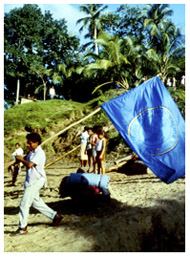 A PAHO team advertises an immunization program, El Salvador, 1980s
A PAHO team advertises an immunization program, El Salvador, 1980s
Courtesy PAHO Archives
As part of a campaign to prevent the spread of infectious diseases across Central America in the 1980s, teams of health care workers traveled through towns and villages to
immunize children against polio, diphtheria, whooping cough, tetanus, and measles.
Next
 Bullet holes in the walls of La Clinica Fatima Pavon, La Trinidad, Nicaragua, 1987
Bullet holes in the walls of La Clinica Fatima Pavon, La Trinidad, Nicaragua, 1987




